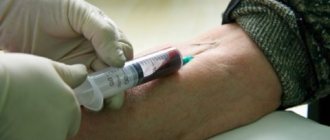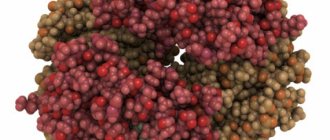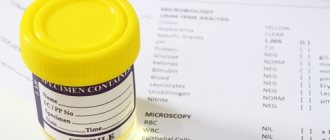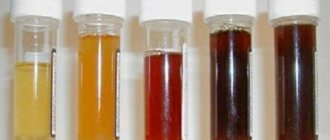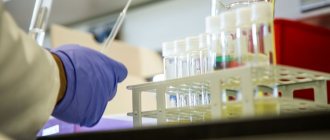The Amburger test is one of the methods for examining urine. Most often, patients who are suspected of having kidney disease - chronic pyelonephritis, glomerulonephritis - are sent for diagnostics.
Thanks to the Amburger test, it is possible to diagnose pathology at a very early stage.
This significantly facilitates treatment and improves the prognosis for recovery.
What is the Amburger test
The Amburger method is a urine test, the essence of which is to determine the number of blood cells in the collected sample.
This study determines the ratio of leukocytes and erythrocytes.
By quantifying blood cells, doctors can successfully diagnose many kidney diseases.
The analysis requires a special centrifuge. In it, blood cells are isolated using a special technique (they settle under the influence of centrifugal force).
Then, in a special chamber (for example, Goryaev’s chamber), the number of leukocytes and erythrocytes is counted.
Normal values
A urine test using the Amburger method involves counting the number of leukocytes and red blood cells deposited in one minute and comparing the results with the norm. The normal red blood cell count is considered to be 1000. If this figure is elevated, this indicates the presence of chronic glomerulonephritis or a disease accompanied by hematuria (the presence of blood in the urine). The number of leukocytes secreted per minute in the urine of a healthy person is 2000. If this figure is exceeded, then the patient suffers from chronic inflammation of the urinary tract and pyelonephritis. Some sources indicate the norm of leukocytes is 2500, and erythrocytes - 2000.
Indications for the purpose of analysis
The Amburger method is very accurate, which allows you to diagnose problems with the genitourinary system at the earliest stages.
The main symptoms on the basis of which the doctor gives a referral for diagnosis include:
- Increased body temperature. A rise in temperature above normal often indicates the presence of some inflammatory processes in the body.
- Constant nausea.
- Vomit.
- Unpleasant sensations or pain in the lumbar region.
- Significant swelling of the extremities.
- Frequent urge to go to the toilet.
- During morning urination, the volume of urine is significantly less than usual.
These signs are enough to suspect diseases of the genitourinary system. The complex of diagnostic measures also includes the Amburger test.
Rules for preparing for material collection
In order to correctly collect urine for analysis using the Amburger method, the patient is required to perform a number of certain actions.
Preparation lasts for three days. This is important to achieve maximum accuracy of analysis results.
All the nuances of preparation will be explained by the attending physician, but the patient must clearly know the main points:
- The day before donating urine, the amount of fluid consumed should be reduced.
- Drinking is prohibited 12 hours before collecting biomaterial.
- You should not take diuretics, as this may distort the results obtained.
- Liquids that contain caffeine should be excluded from the diet. There is also a ban on intensely colored drinks such as juice.
- Drinking alcohol before taking the test is prohibited.
- The day before the test, you should stop eating spicy and salty foods.
- Women during menstruation should not take a sample, as the test result will be incorrect.
- Before collecting biomaterial, you should wash thoroughly.
- Urine is collected in a disposable sterile glass.
Improper preparation for a urine test according to Amburge can significantly distort the results and lead to an incorrect diagnosis.
How to collect material
After preliminary preparation, you can begin the process of collecting biomaterial.
The algorithm for collecting biomaterial for urine analysis according to Amburge is quite simple:
- During the morning visit to the toilet, the patient should completely empty the bladder. Even a small amount of urine remaining in the organ can distort the result.
- It is important to record the time of urination.
- It is forbidden to go to the toilet for three hours.
- After this, you need to collect the urine in a container for analysis. You need to wash yourself well first.
During the waiting period between the start of the analysis and the urine collection itself, there are no restrictions on food and water intake.
The rules for collecting urine are simple. Their careful observance will allow you to obtain the most reliable results.
Urine for testing - how to collect?
It would seem that it would be easier to take a urine test? But it turns out that the reliability of the result depends on how exactly you collect urine, in what container and at what time of day. How you collect urine directly depends on the test you take. In this article we will look at the basic rules for collecting urine for different types of analysis.
Classification of urine examination
At every preventive examination in the hospital, medical examination, registration for pregnancy and examinations, as well as in case of illness, doctors give directions to patients for a general urine test. If the patient has any diseases in the form of kidney disease, urethra, disruption of the cardiovascular and endocrine systems, then in this case it is recommended to take urine tests such as:
- Nechiporenko test;
- Amburger's test;
- Addis-Kakovsky test;
- Zimnitsky test;
- Urinalysis for sterility;
- Culture of urine for flora;
- Analysis of urine sensitivity to certain antibiotics;
- Biochemical urine analysis;
- Two-glass urine sample;
- Three-glass sample;
- Rehberg's test;
- Prednisolone test;
- Load test.
Most of the above tests are carried out without special preparation (the patient only needs to bring urine collected at home to the laboratory), while other studies require the direct intervention of medical personnel.
But, nevertheless, for each of these analyzes it will be necessary to undergo special training.
Why is urine analysis not always reliable? The reason is that doctors do not always explain in detail to patients how to collect urine at home. As a result, a person can bring the analysis in an ordinary glass food jar with the presence of impurities and some kind of contaminants; not all patients follow hygiene rules before submitting urine to the laboratory, etc. As a result of all this, the patient receives an unreliable test result. What could this lead to? This means that a person may be given a false diagnosis or, on the contrary, a serious disease that currently requires treatment may not be detected.
If the test result turns out to be doubtful, then the doctor may prescribe the patient an additional urine test. But again! A patient, due to ignorance of basic things about how to take a particular test, how to properly collect it and prepare for it, can receive a false test result over and over again.
Your diagnosis, treatment prescription, and your health in general will depend on how correctly you collect a urine test at home.
It is also no secret for every parent that collecting urine from young children is also a problem, because not all children (especially small ones) can independently and consciously control the process of urination. But, even in children, most tests can be collected correctly if you know exactly how to do it.
Taking a general urine test
In order to prepare for a general urine test, you must first prepare:
- Perform thorough hygiene of the genitals (wash with baby soap or special detergents);
- A urine container must be purchased in advance from a pharmacy (these are small containers for collecting urine with a volume of 100 ml);
- Urine is collected after a night's sleep - in the morning;
- After collecting urine, the samples must be delivered to the laboratory within two hours;
- Before you collect urine in a container, you need to release a little urine into the bathtub or toilet (this will eliminate the possibility of bacteria from the surface of the urethra and vagina, as well as epithelial cells, getting into the analysis). The second portion of urine is drained into a container for collecting samples.
Nechiporenko test
Before preparing to collect urine for the Nechiporenko test analysis, you must:
- Perform thorough hygiene of the genital organs;
- Urine is collected in the morning;
- The first portion of urine is flushed down the toilet, the middle portion is collected, then the remainder is flushed down the toilet.
Amburger's test
In order to prepare for collecting urine using the Amburger test, you need to:
- Prepare a container for collecting urine with a volume of at least 1 liter;
- Check with your doctor in advance about the required time for urine collection;
- For analysis, you will need to collect the urine that a person has excreted for 4 hours (during this period, a person can eat and drink liquid in the same volume as usual);
- The first portion of urine is collected at 7 a.m., then, over the next 4 hours, the remaining accumulated urine is collected. In small children, in such cases, a special urinal is used.
Preparation of urine for the Addis-Kakovsky test
In order to collect a urine test for the Addis-Kakowski test, it is necessary to limit fluid intake on the day on which the urine collection will be carried out. Fluid intake is not limited only in the case of urine collection in young children.
Urine is collected in a 2-liter container. Urine collection is carried out over a period of 12 hours or 24 hours (as prescribed by a doctor). After 20:00 one day, the collection of analysis begins and ends at 08:00 the next day.
Zimnitsky test
For the Zimnitsky test, it is first necessary to carry out hygiene of the genital organs of an adult or a child. For analysis, 8 containers for urine collection are prepared, on each of which it is necessary to indicate time intervals every 3 hours (from 06:00 to 09:00, from 09:00 to 12:00, from 12:00 to 15:00, from 15:00 to 18:00….the last 8th container will be signed as 03:00-06:00). It will be necessary to collect in containers all the urine that a child or adult secretes during the day.
There is no point in deliberately drinking more fluid than a person usually manages. Even if a person has not urinated for 3 hours, a dash is placed in the column and the laboratory assistant is informed about this. To collect this analysis, young children must first secure a urine bag and check it each time to pour the contents into the container.
Interesting articles:
medportal.su
Conducting research
The Amburger method is a rather complex study. To carry out this, the laboratory assistant needs:
- a measuring tube designed for use in a centrifuge;
- pipette 10 ml;
- counting chamber;
- glass rod;
- microscope;
- centrifuge.
The study itself is carried out as follows:
- Urine collected for analysis using the Amburger method is submitted to a diagnostic laboratory.
- The biomaterial is transferred to a special centrifuge tube.
- Urine is divided into fractions by centrifugation for 5 minutes.
- The height of the upper fraction must be at least 1 cm. It is drained as unnecessary.
- Repeated centrifugation of the sediment at a speed of 2000 rpm.
- Remove the top fraction again.
- In the resulting material (pre-mixed), the number of leukocytes and erythrocytes is counted. To do this, use a counting chamber.
Based on the results obtained, the doctor makes a conclusion about the presence or absence of the disease.
Methodology
The study is carried out in a clinical laboratory by a laboratory technician.
Its implementation includes several stages:
- Take 10 ml from urine collected over a 3-hour period of time.
- Place in a centrifuge for 5 minutes at 2000 rpm
- Remove the supernatant so that 1 ml of sediment remains at the bottom.
- Mix the sediment and fill the counting chamber with it, calculating leukocytes and erythrocytes in 1 µl.
Cells are calculated using the formula: Q =( x · 1000 · v)/ s · t, where:
- Q – number of cells in the volume of urine received per minute,
- x – number of counted cells in the chamber (for leukocytes and erythrocytes separately)
- s – amount of urine taken for centrifugation (10)
- v is the volume of urine obtained in 3 hours.
- t – time during which urine was collected (3 hours = 180 minutes).
The resulting number in 1 µl multiplied by 1000 (1 ml = 1000 µl).
Results: norm and deviations
As a result of urine analysis using the Amburger method, information is obtained on the quantitative content of leukocytes and erythrocytes. In order to interpret these values, they are compared with a conventionally accepted standard.
Scientists have accepted that the standard showing the complete absence of disorders in the genitourinary system is the following indicators:
- leukocytes – 2000 pcs.;
- red blood cells – 1000 pcs.
Deviation of no more than 10% is allowed.
If, when interpreting the tests, a significant discrepancy with normal values is revealed, the presence of some kind of disease can be assumed.
To understand the results of the study, it is important to know what role white blood cells and red blood cells play in the human body, and under what conditions their number can increase and decrease.
- Leukocytes. Their increased content indicates inflammatory processes occurring in the organs of the urinary system. In addition, their increase is possible after injury or surgery.
- Red blood cells. Their excess quantity indicates that pathological processes are occurring in the human body that require urgent medical intervention.
The main reasons for possible deviations include the following pathologies:
- Pyelonephritis. Infectious and inflammatory lesions of the renal pelvis and calyces. With this pathology, an increased number of leukocytes will be observed in the urine sample. The erythrocyte count is normal.
- Glomerulonephritis. An autoimmune disease that affects the glomeruli. When analyzing the analysis using the Amburger method, a significant excess of red blood cells will be detected in patients suffering from this pathology. The number of leukocytes is normal.
- Cystitis. Inflammatory disease of the bladder. With it, an increase in the content of leukocytes in the urine is observed.
- A variety of purulent-inflammatory processes occurring in the kidneys. The urine contains a significant number of leukocytes.
If the result of the Amburger test shows a reduced number of both leukocytes and erythrocytes, the sample is considered unreliable. Repetition of the analysis is required.
How to correctly collect a general urine test
Urine (urine) is a biological fluid that contains products of internal metabolic processes and is secreted by the organs of the urinary system.
General clinical urine examination is one of the most common laboratory diagnostic methods. It is what practitioners prescribe for preventive medical examinations, diseases of the genitourinary system, inflammatory processes in the body, and diabetes.
In clinical diagnostic laboratories, samples of biological material undergo a thorough evaluation - their physicochemical and biochemical characteristics are studied, and microscopy of urinary sediment is performed. Determining all urine parameters greatly facilitates diagnosing the patient’s pathological condition and allows rational treatment to be prescribed.
However, to obtain reliable results, it is necessary to collect high-quality urine for analysis. Of course, the attending physician must explain to the patient the existing algorithm for collecting biological fluid. But it is not always possible to write down or remember all the important points, so in our article we want to talk in detail about how to collect a general urine test.
How does urine formation occur?
Urine is formed by filtering circulating blood through special layers of the kidneys - the glomeruli and tubules; this process takes place in two stages:
- Glomerular ultrafiltration (formation of provisional urine) - blood enters the kidneys through the vessels, where, due to high pressure in the capillaries, excess fluid with harmful components dissolved in it comes out. In 60 minutes, the volume of primary urine reaches 8 liters. The inner layer of the vessels of the renal glomeruli allows only certain components to pass through (water and substances dissolved in it). The capillary endothelium remains impermeable to formed elements and proteins. That is why the results of a general urine test of a healthy person do not contain detected total protein and red blood cells.
- Tubular reabsorption (reverse absorption) - primary urine passes through the tubules of the kidneys, and 7/8 of its volume, containing water, glucose, vitamins, amino acids and salts, is absorbed into the blood. The remainder of the urine contains foreign substances, organic acids, and end products of metabolic processes.
Why is a urine test prescribed?
Laboratory testing of urine provides the doctor with an opportunity to evaluate the patient's overall health. It is carried out as part of both preventive and diagnostic measures to identify pathologies of the urinary system:
- pyelonephritis;
- urolithiasis;
- glomerulonephritis;
- amyloidosis;
- cystitis;
- prostatitis;
- nephrosclerosis;
- kidney tuberculosis;
- malignant neoplasms.
Basic rules for collecting biological fluid
It is not difficult to follow all the necessary rules for collecting urine for a general analysis. However, not all patients know when to start preparing for the study, at what time to collect biological material, in what amount and in what quantity. So:
- Preparation for the study begins on the day the patient receives a referral for a general analysis (usually this happens 1-2 days before the appointed date). From this moment on, it is necessary to exclude the consumption of alcoholic and carbonated drinks, products containing natural and synthetic dyes (blueberries, beets, carrots, oranges, candies, spinach). It is undesirable to eat spicy, smoked and salty foods, or take diuretics.
- On the eve of collecting biomaterial, it is necessary to limit physical and psycho-emotional stress.
- It is important to prepare sterile containers in advance - it is advisable to purchase a special container for collecting biological fluid at the pharmacy. If this is not possible, any glass container with a tight lid is allowed; it must be thoroughly washed and doused with boiling water.
- Urine is collected in the morning, after an overnight delay (at least 5 hours must have passed since the last urination).
- Before collecting biological fluid, the external genitalia must be toileted.
- The first portion of urine is released into the toilet, the rest into a container.
- It is necessary to tightly close the container and deliver the collected biomaterial to the laboratory center no later than two hours. Otherwise, the formed elements of urine will begin to decompose - this will affect the reliability of the research results.
Features of collecting children's urine
In order to correctly collect urine for general analysis from an infant, parents need to make a lot of effort - after all, the baby cannot yet control the urge to urinate and it is also not possible to recognize them. If in order to collect biological fluid, boys simply need to remove the diaper and place a container, then the parents of girls do not even know how to approach this problem.
If it is not possible to buy it, you can use:
- a dry plate, thoroughly washed and treated with boiling water - it is carefully placed under the baby’s buttocks;
- a clean disposable plastic bag - a “shirt”, which is secured to the baby’s hips using handles.
It is very important for parents not to forget about the cleanliness of the external genitalia. If the baby is breastfed, the mother needs to remember about her own diet.
You need to collect urine from a child in the morning; you can speed up the process of urination by feeding the baby and stroking along the back. After the baby has emptied the bladder, the collected urine must be poured into a container for delivery of the biomaterial to the laboratory center.
The algorithm of actions is the same as for adults:
- Do not forget about preliminary preparation - it is not recommended to eat food containing dyes, maintain a normal water regime, and go to bed at the same time.
- It is necessary to collect biological fluid in the morning.
- Carry out hygienic procedures for the external genitalia quickly - babies cannot hold urination for a long time.
- Ask the child to defecate into a prepared container, but not into a potty. Urine poured from a non-sterile container will contain pathogens that will distort the results of a diagnostic test.
- You need to collect the entire portion of urine, mix it, pour about 50-80 ml into a special container and deliver it to a clinical diagnostic laboratory.
Advantages and disadvantages of the Amburger method
The Amburge urine test cannot be called an ideal diagnostic method. It has both its strengths and weaknesses.
The main advantages of the method include:
- High research accuracy.
- High sensitivity to changes in the number of leukocytes and erythrocytes. This allows the disease to be diagnosed even at an early stage.
- Most available in outpatient settings.
The analysis allows you to diagnose kidney disease and, accordingly, begin the correct treatment in a timely manner.
Among the disadvantages it should be noted:
- Limiting fluid intake during preparation for analysis.
- For some patients, the condition of not going to the toilet for three hours is impossible.
- In some cases, the patient has great difficulty complying with the requirement to completely empty the bladder. For example, with diseases such as adenoma and prostate cancer, this condition is practically impossible to fulfill.
- If one kidney is affected, the Amburger method will give an incorrect result. Since urine is produced by both organs, the number of leukocytes and red blood cells is the average result of the work of the two kidneys. Accordingly, the severity of the disease is incorrectly assessed, and time will be lost.
Also, this method is not available for bedridden patients.

